Abstract
Transmission of human immunodeficiency virus 1 (HIV-1) from an infected women to her offspring during gestation and delivery was found to be influenced by the infant's major histocompatibility complex class II DRB1 alleles. Forty-six HIV-infected infants and 63 seroreverting infants, born with passively acquired anti-HIV antibodies but not becoming detectably infected, were typed by an automated nucleotide-sequence-based technique that uses low-resolution PCR to select either the simpler Taq or the more demanding T7 sequencing chemistry. One or more DR13 alleles, including DRB1*1301, 1302, and 1303, were found in 31.7% of seroreverting infants and 15.2% of those becoming HIV-infected [OR (odds ratio) = 2.6 (95% confidence interval 1.0-6.8); P = 0.048]. This association was influenced by ethnicity, being seen more strongly among the 80 Black and Hispanic children [OR = 4.3 (1.2-16.4); P = 0.023], with the most pronounced effect among Black infants where 7 of 24 seroreverters inherited these alleles with none among 12 HIV-infected infants (Haldane OR = 12.3; P = 0.037). The previously recognized association of DR13 alleles with some situations of long-term nonprogression of HIV suggests that similar mechanisms may regulate both the occurrence of infection and disease progression after infection. Upon examining for residual associations, only only the DR2 allele DRB1*1501 was associated with seroreversion in Caucasoid infants (OR = 24; P = 0.004). Among Caucasoids the DRB1*03011 allele was positively associated with the occurrence of HIV infection (P = 0.03).
Full text
PDF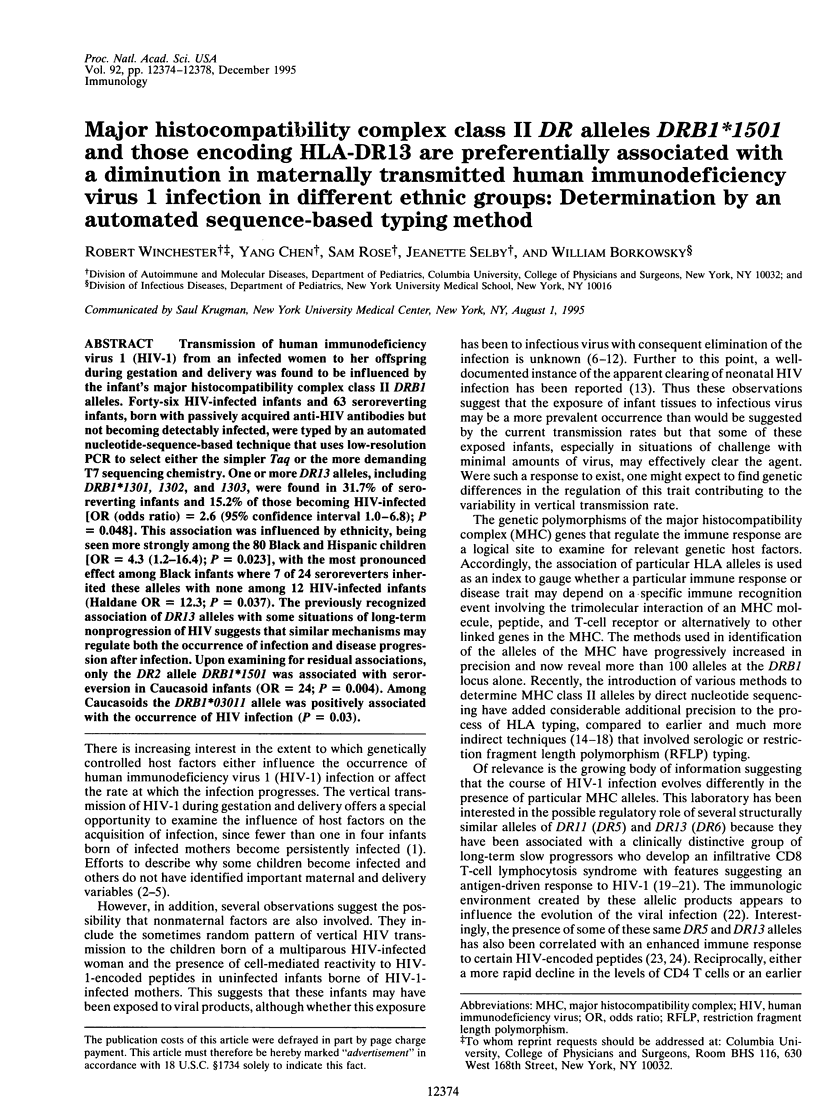
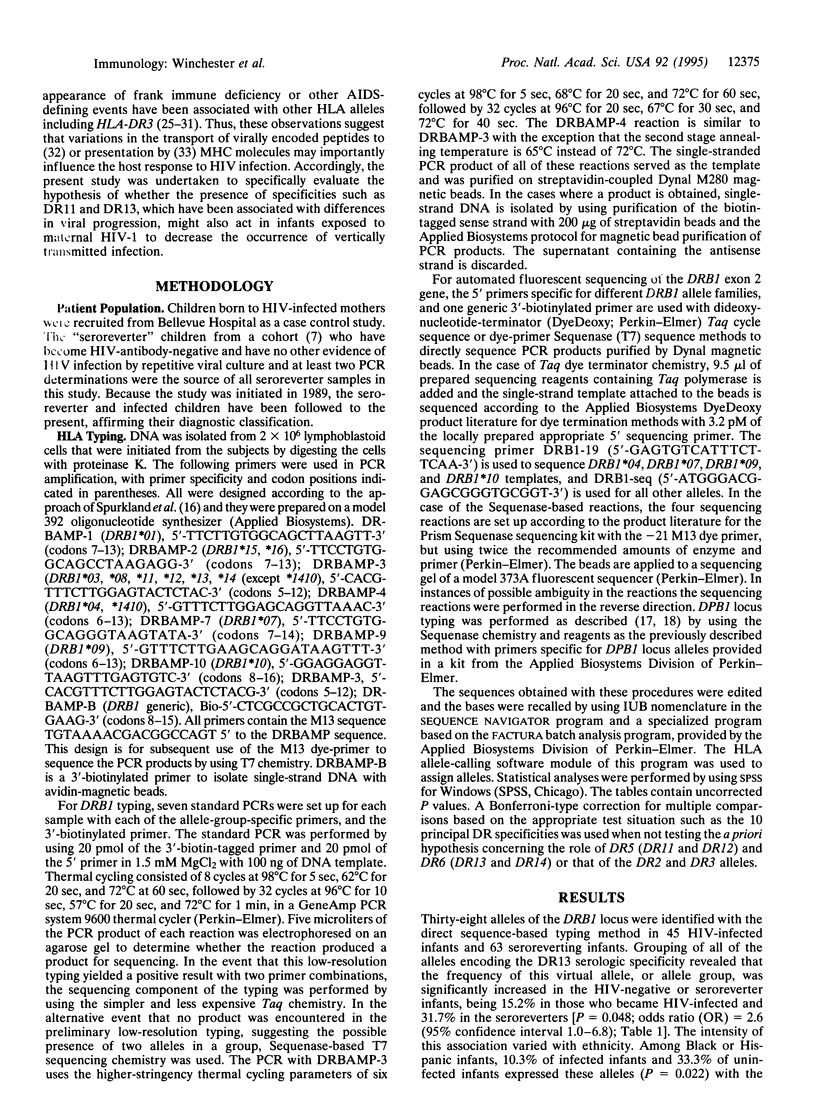
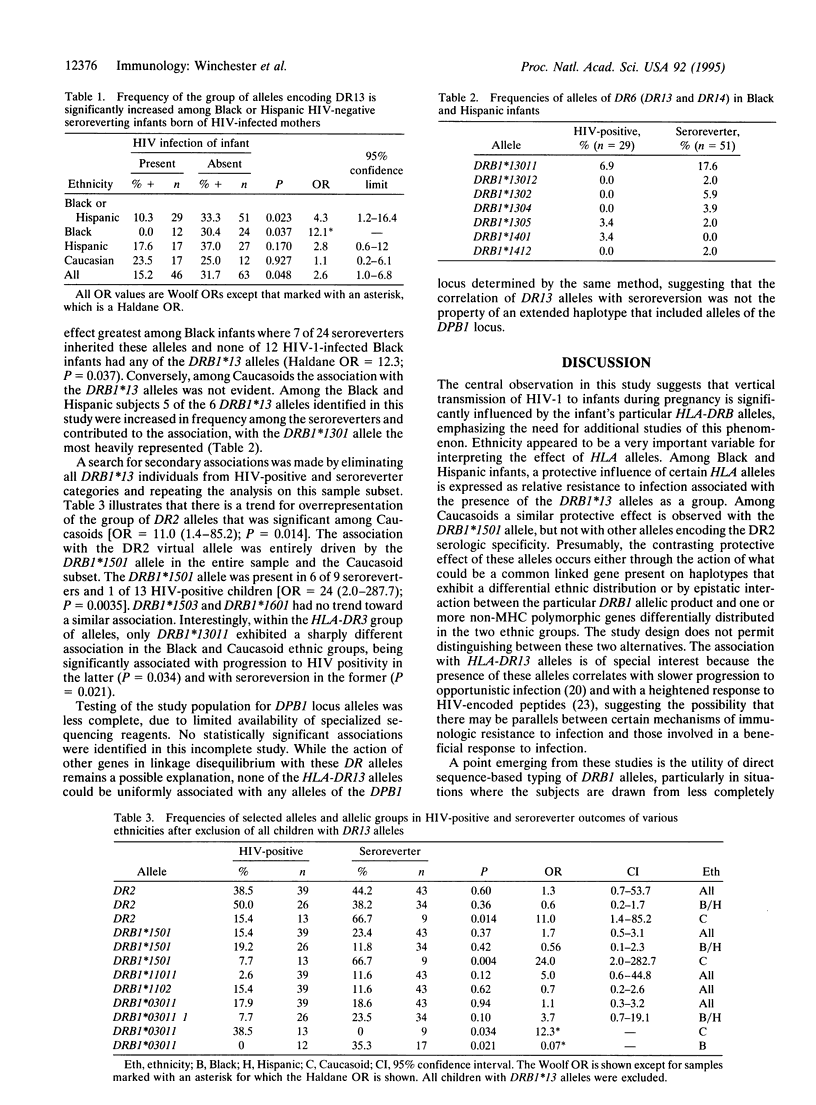
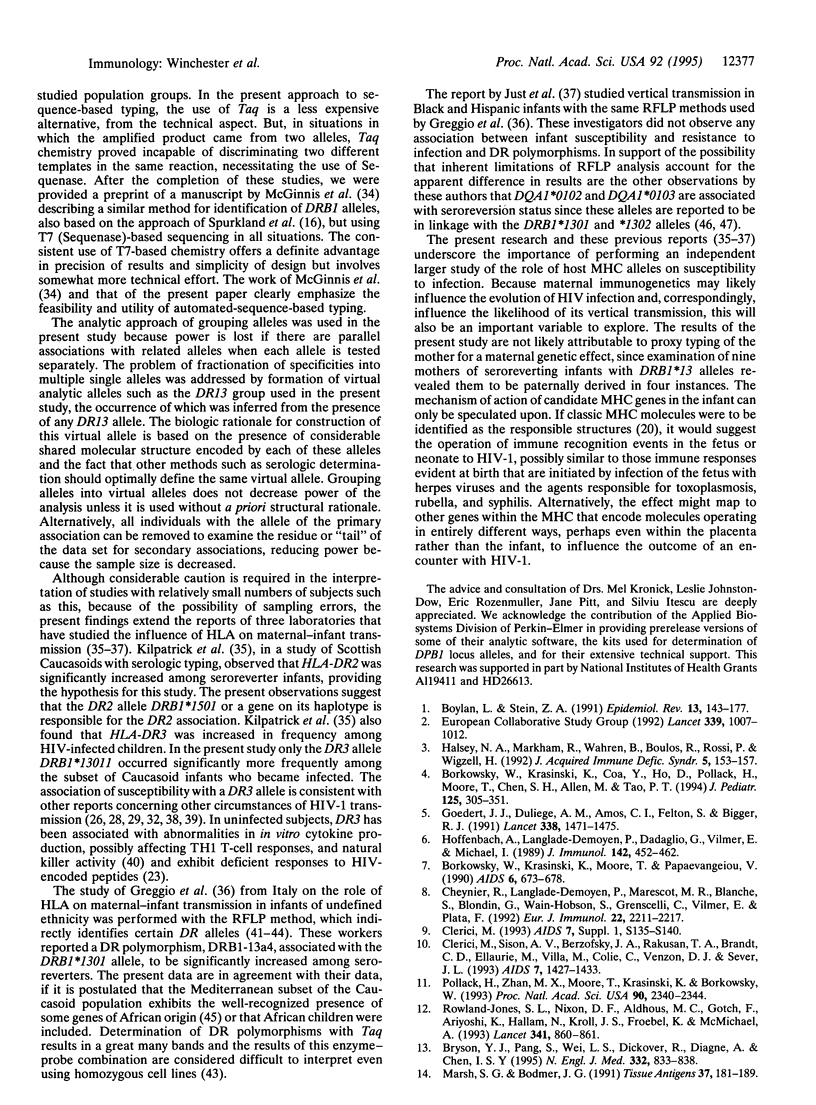
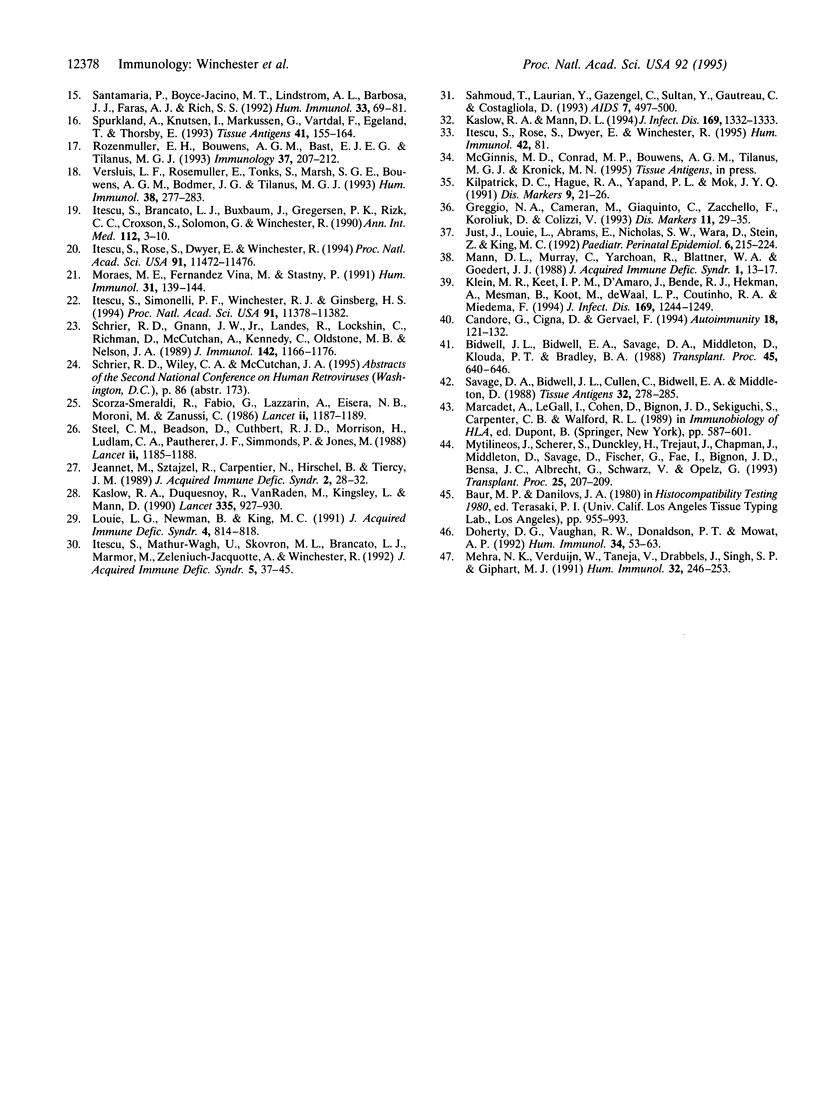
Selected References
These references are in PubMed. This may not be the complete list of references from this article.
- Bidwell J. L., Bidwell E. A., Savage D. A., Middleton D., Klouda P. T., Bradley B. A. A DNA-RFLP typing system that positively identifies serologically well-defined and ill-defined HLA-DR and DQ alleles, including DRw10. Transplantation. 1988 Mar;45(3):640–646. doi: 10.1097/00007890-198803000-00027. [DOI] [PubMed] [Google Scholar]
- Borkowsky W., Krasinski K., Cao Y., Ho D., Pollack H., Moore T., Chen S. H., Allen M., Tao P. T. Correlation of perinatal transmission of human immunodeficiency virus type 1 with maternal viremia and lymphocyte phenotypes. J Pediatr. 1994 Sep;125(3):345–351. doi: 10.1016/s0022-3476(05)83274-3. [DOI] [PubMed] [Google Scholar]
- Borkowsky W., Krasinski K., Moore T., Papaevangelou V. Lymphocyte proliferative responses to HIV-1 envelope and core antigens by infected and uninfected adults and children. AIDS Res Hum Retroviruses. 1990 May;6(5):673–678. doi: 10.1089/aid.1990.6.673. [DOI] [PubMed] [Google Scholar]
- Boylan L., Stein Z. A. The epidemiology of HIV infection in children and their mothers--vertical transmission. Epidemiol Rev. 1991;13:143–177. doi: 10.1093/oxfordjournals.epirev.a036067. [DOI] [PubMed] [Google Scholar]
- Bryson Y. J., Pang S., Wei L. S., Dickover R., Diagne A., Chen I. S. Clearance of HIV infection in a perinatally infected infant. N Engl J Med. 1995 Mar 30;332(13):833–838. doi: 10.1056/NEJM199503303321301. [DOI] [PubMed] [Google Scholar]
- Candore G., Cigna D., Gervasi F., Colucci A. T., Modica M. A., Caruso C. In vitro cytokine production by HLA-B8,DR3 positive subjects. Autoimmunity. 1994;18(2):121–132. doi: 10.3109/08916939409007985. [DOI] [PubMed] [Google Scholar]
- Cheynier R., Langlade-Demoyen P., Marescot M. R., Blanche S., Blondin G., Wain-Hobson S., Griscelli C., Vilmer E., Plata F. Cytotoxic T lymphocyte responses in the peripheral blood of children born to human immunodeficiency virus-1-infected mothers. Eur J Immunol. 1992 Sep;22(9):2211–2217. doi: 10.1002/eji.1830220905. [DOI] [PubMed] [Google Scholar]
- Clerici M. Cell-mediated immunity in HIV infection. AIDS. 1993;7 (Suppl 1):S135–S140. [PubMed] [Google Scholar]
- Clerici M., Sison A. V., Berzofsky J. A., Rakusan T. A., Brandt C. D., Ellaurie M., Villa M., Colie C., Venzon D. J., Sever J. L. Cellular immune factors associated with mother-to-infant transmission of HIV. AIDS. 1993 Nov;7(11):1427–1433. doi: 10.1097/00002030-199311000-00004. [DOI] [PubMed] [Google Scholar]
- Doherty D. G., Vaughan R. W., Donaldson P. T., Mowat A. P. HLA DQA, DQB, and DRB genotyping by oligonucleotide analysis: distribution of alleles and haplotypes in British caucasoids. Hum Immunol. 1992 May;34(1):53–63. doi: 10.1016/0198-8859(92)90085-2. [DOI] [PubMed] [Google Scholar]
- Goedert J. J., Duliège A. M., Amos C. I., Felton S., Biggar R. J. High risk of HIV-1 infection for first-born twins. The International Registry of HIV-exposed Twins. Lancet. 1991 Dec 14;338(8781):1471–1475. doi: 10.1016/0140-6736(91)92297-f. [DOI] [PubMed] [Google Scholar]
- Greggio N. A., Cameran M., Giaquinto C., Zacchello F., Koroliuk D., Colizzi V. DNA HLA-DRB1 analysis in children of positive mothers and estimated risk of vertical HIV transmission. Dis Markers. 1993 Jun;11(1):29–35. doi: 10.1155/1993/292684. [DOI] [PubMed] [Google Scholar]
- Halsey N. A., Markham R., Wahren B., Boulos R., Rossi P., Wigzell H. Lack of association between maternal antibodies to V3 loop peptides and maternal-infant HIV-1 transmission. J Acquir Immune Defic Syndr. 1992;5(2):153–157. [PubMed] [Google Scholar]
- Hoffenbach A., Langlade-Demoyen P., Dadaglio G., Vilmer E., Michel F., Mayaud C., Autran B., Plata F. Unusually high frequencies of HIV-specific cytotoxic T lymphocytes in humans. J Immunol. 1989 Jan 15;142(2):452–462. [PubMed] [Google Scholar]
- Itescu S., Brancato L. J., Buxbaum J., Gregersen P. K., Rizk C. C., Croxson T. S., Solomon G. E., Winchester R. A diffuse infiltrative CD8 lymphocytosis syndrome in human immunodeficiency virus (HIV) infection: a host immune response associated with HLA-DR5. Ann Intern Med. 1990 Jan 1;112(1):3–10. doi: 10.7326/0003-4819-112-1-3. [DOI] [PubMed] [Google Scholar]
- Itescu S., Mathur-Wagh U., Skovron M. L., Brancato L. J., Marmor M., Zeleniuch-Jacquotte A., Winchester R. HLA-B35 is associated with accelerated progression to AIDS. J Acquir Immune Defic Syndr. 1992;5(1):37–45. [PubMed] [Google Scholar]
- Itescu S., Rose S., Dwyer E., Winchester R. Certain HLA-DR5 and -DR6 major histocompatibility complex class II alleles are associated with a CD8 lymphocytic host response to human immunodeficiency virus type 1 characterized by low lymphocyte viral strain heterogeneity and slow disease progression. Proc Natl Acad Sci U S A. 1994 Nov 22;91(24):11472–11476. doi: 10.1073/pnas.91.24.11472. [DOI] [PMC free article] [PubMed] [Google Scholar]
- Itescu S., Rose S., Dwyer E., Winchester R. Grouping HLA-B locus serologic specificities according to shared structural motifs suggests that different peptide-anchoring pockets may have contrasting influences on the course of HIV-1 infection. Hum Immunol. 1995 Jan;42(1):81–89. doi: 10.1016/0198-8859(94)00081-z. [DOI] [PubMed] [Google Scholar]
- Itescu S., Simonelli P. F., Winchester R. J., Ginsberg H. S. Human immunodeficiency virus type 1 strains in the lungs of infected individuals evolve independently from those in peripheral blood and are highly conserved in the C-terminal region of the envelope V3 loop. Proc Natl Acad Sci U S A. 1994 Nov 22;91(24):11378–11382. doi: 10.1073/pnas.91.24.11378. [DOI] [PMC free article] [PubMed] [Google Scholar]
- Jeannet M., Sztajzel R., Carpentier N., Hirschel B., Tiercy J. M. HLA antigens are risk factors for development of AIDS. J Acquir Immune Defic Syndr. 1989;2(1):28–32. [PubMed] [Google Scholar]
- Just J., Louie L., Abrams E., Nicholas S. W., Wara D., Stein Z., King M. C. Genetic risk factors for perinatally acquired HIV-1 infection. Paediatr Perinat Epidemiol. 1992 Apr;6(2):215–224. doi: 10.1111/j.1365-3016.1992.tb00762.x. [DOI] [PubMed] [Google Scholar]
- Kaslow R. A., Duquesnoy R., VanRaden M., Kingsley L., Marrari M., Friedman H., Su S., Saah A. J., Detels R., Phair J. A1, Cw7, B8, DR3 HLA antigen combination associated with rapid decline of T-helper lymphocytes in HIV-1 infection. A report from the Multicenter AIDS Cohort Study. Lancet. 1990 Apr 21;335(8695):927–930. doi: 10.1016/0140-6736(90)90995-h. [DOI] [PubMed] [Google Scholar]
- Kaslow R. A., Mann D. L. The role of the major histocompatibility complex in human immunodeficiency virus infection--ever more complex? J Infect Dis. 1994 Jun;169(6):1332–1333. doi: 10.1093/infdis/169.6.1332. [DOI] [PubMed] [Google Scholar]
- Kilpatrick D. C., Hague R. A., Yap P. L., Mok J. Y. HLA antigen frequencies in children born to HIV-infected mothers. Dis Markers. 1991 Jan-Feb;9(1):21–26. [PubMed] [Google Scholar]
- Klein M. R., Keet I. P., D'Amaro J., Bende R. J., Hekman A., Mesman B., Koot M., de Waal L. P., Coutinho R. A., Miedema F. Associations between HLA frequencies and pathogenic features of human immunodeficiency virus type 1 infection in seroconverters from the Amsterdam cohort of homosexual men. J Infect Dis. 1994 Jun;169(6):1244–1249. doi: 10.1093/infdis/169.6.1244. [DOI] [PubMed] [Google Scholar]
- Louie L. G., Newman B., King M. C. Influence of host genotype on progression to AIDS among HIV-infected men. J Acquir Immune Defic Syndr. 1991;4(8):814–818. [PubMed] [Google Scholar]
- Mann D. L., Murray C., Yarchoan R., Blattner W. A., Goedert J. J. HLA antigen frequencies in HIV-1 seropositive disease-free individuals and patients with AIDS. J Acquir Immune Defic Syndr. 1988;1(1):13–17. [PubMed] [Google Scholar]
- Marsh S. G., Bodmer J. G. HLA class II nucleotide sequences, 1991. Tissue Antigens. 1991 Apr;37(4):181–189. doi: 10.1111/j.1399-0039.1991.tb01870.x. [DOI] [PubMed] [Google Scholar]
- Mehra N. K., Verduijn W., Taneja V., Drabbels J., Singh S. P., Giphart M. J. Analysis of HLA-DR2-associated polymorphisms by oligonucleotide hybridization in an Asian Indian population. Hum Immunol. 1991 Dec;32(4):246–253. doi: 10.1016/0198-8859(91)90087-p. [DOI] [PubMed] [Google Scholar]
- Moraes M. E., Fernandez-Viña M., Stastny P. DNA typing for class II HLA antigens with allele-specific or group-specific amplification. IV. Typing for alleles of the HLA-DR2 group. Hum Immunol. 1991 Jun;31(2):139–144. doi: 10.1016/0198-8859(91)90017-4. [DOI] [PubMed] [Google Scholar]
- Mytilineos J., Scherer S., Dunckley H., Trejaut J., Chapman J., Middleton D., Savage D., Fischer G., Fae I., Bignon J. D. DNA typing of 3500 cadaver kidney transplants does not confirm the "DR6 effect". Transplant Proc. 1993 Feb;25(1 Pt 1):207–209. [PubMed] [Google Scholar]
- Pollack H., Zhan M. X., Ilmet-Moore T., Ajuang-Simbiri K., Krasinski K., Borkowsky W. Ontogeny of anti-human immunodeficiency virus (HIV) antibody production in HIV-1-infected infants. Proc Natl Acad Sci U S A. 1993 Mar 15;90(6):2340–2344. doi: 10.1073/pnas.90.6.2340. [DOI] [PMC free article] [PubMed] [Google Scholar]
- Rowland-Jones S. L., Nixon D. F., Aldhous M. C., Gotch F., Ariyoshi K., Hallam N., Kroll J. S., Froebel K., McMichael A. HIV-specific cytotoxic T-cell activity in an HIV-exposed but uninfected infant. Lancet. 1993 Apr 3;341(8849):860–861. doi: 10.1016/0140-6736(93)93063-7. [DOI] [PubMed] [Google Scholar]
- Rozemuller E. H., Bouwens A. G., Bast B. E., Tilanus M. G. Assignment of HLA-DPB alleles by computerized matching based upon sequence data. Hum Immunol. 1993 Aug;37(4):207–212. doi: 10.1016/0198-8859(93)90503-s. [DOI] [PubMed] [Google Scholar]
- Sahmoud T., Laurian Y., Gazengel C., Sultan Y., Gautreau C., Costagliola D. Progression to AIDS in French haemophiliacs: association with HLA-B35. AIDS. 1993 Apr;7(4):497–500. doi: 10.1097/00002030-199304000-00007. [DOI] [PubMed] [Google Scholar]
- Santamaria P., Boyce-Jacino M. T., Lindstrom A. L., Barbosa J. J., Faras A. J., Rich S. S. HLA class II "typing": direct sequencing of DRB, DQB, and DQA genes. Hum Immunol. 1992 Feb;33(2):69–81. doi: 10.1016/0198-8859(92)90056-s. [DOI] [PubMed] [Google Scholar]
- Savage D. A., Bidwell J. L., Cullen C., Bidwell E. A., Middleton D. Identification of HLA-DRw52 associated antigens using HLA class II allogenotyping. Tissue Antigens. 1988 Nov;32(5):278–285. doi: 10.1111/j.1399-0039.1988.tb01667.x. [DOI] [PubMed] [Google Scholar]
- Schrier R. D., Gnann J. W., Jr, Landes R., Lockshin C., Richman D., McCutchan A., Kennedy C., Oldstone M. B., Nelson J. A. T cell recognition of HIV synthetic peptides in a natural infection. J Immunol. 1989 Feb 15;142(4):1166–1176. [PubMed] [Google Scholar]
- Scorza Smeraldi R., Fabio G., Lazzarin A., Eisera N. B., Moroni M., Zanussi C. HLA-associated susceptibility to acquired immunodeficiency syndrome in Italian patients with human-immunodeficiency-virus infection. Lancet. 1986 Nov 22;2(8517):1187–1189. doi: 10.1016/s0140-6736(86)92197-5. [DOI] [PubMed] [Google Scholar]
- Spurkland A., Knutsen I., Markussen G., Vartdal F., Egeland T., Thorsby E. HLA matching of unrelated bone marrow transplant pairs: direct sequencing of in vitro amplified HLA-DRB1 and -DQB1 genes using magnetic beads as solid support. Tissue Antigens. 1993 Mar;41(3):155–164. doi: 10.1111/j.1399-0039.1993.tb01995.x. [DOI] [PubMed] [Google Scholar]
- Steel C. M., Ludlam C. A., Beatson D., Peutherer J. F., Cuthbert R. J., Simmonds P., Morrison H., Jones M. HLA haplotype A1 B8 DR3 as a risk factor for HIV-related disease. Lancet. 1988 May 28;1(8596):1185–1188. doi: 10.1016/s0140-6736(88)92009-0. [DOI] [PubMed] [Google Scholar]
- Versluis L. F., Rozemuller E., Tonks S., Marsh S. G., Bouwens A. G., Bodmer J. G., Tilanus M. G. High-resolution HLA-DPB typing based upon computerized analysis of data obtained by fluorescent sequencing of the amplified polymorphic exon 2. Hum Immunol. 1993 Dec;38(4):277–283. doi: 10.1016/0198-8859(93)90555-f. [DOI] [PubMed] [Google Scholar]


